Perturbation of transcription elongation influences the fidelity of internal exon inclusion in Saccharomyces cerevisiae
- PMID: 12869710
- PMCID: PMC1370465
- DOI: 10.1261/rna.5390803
Perturbation of transcription elongation influences the fidelity of internal exon inclusion in Saccharomyces cerevisiae
Abstract
Unknown mechanisms exist to ensure that exons are not skipped during biogenesis of mRNA. Studies have connected transcription elongation with regulated alternative exon inclusion. To determine whether the relative rates of transcription elongation and spliceosome assembly might play a general role in enforcing constitutive exon inclusion, we measured exon skipping for a natural two-intron gene in which the internal exon is constitutively included in the mRNA. Mutations in this gene that subtly reduce recognition of the intron 1 branchpoint cause exon skipping, indicating that rapid recognition of the first intron is important for enforcing exon inclusion. To test the role of transcription elongation, we treated cells to increase or decrease the rate of transcription elongation. Consistent with the "first come, first served" model, we found that exon skipping in vivo is inhibited when transcription is slowed by RNAP II mutants or when cells are treated with inhibitors of elongation. Expression of the elongation factor TFIIS stimulates exon skipping, and this effect is eliminated when lac repressor is targeted to DNA encoding the second intron. A mutation in U2 snRNA promotes exon skipping, presumably because a delay in recognition of the first intron allows elongating RNA polymerase to transcribe the downstream intron. This indicates that the relative rates of elongation and splicing are tuned so that the fidelity of exon inclusion is enhanced. These findings support a general role for kinetic coordination of transcription elongation and splicing during the transcription-dependent control of splicing.
Figures

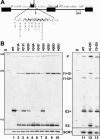
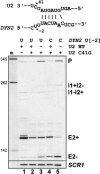
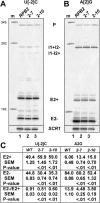
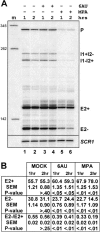
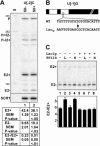
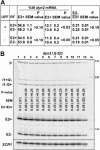

Similar articles
-
Intron self-complementarity enforces exon inclusion in a yeast pre-mRNA.Proc Natl Acad Sci U S A. 1997 Nov 11;94(23):12467-72. doi: 10.1073/pnas.94.23.12467. Proc Natl Acad Sci U S A. 1997. PMID: 9356473 Free PMC article.
-
Pre-mRNA splicing is facilitated by an optimal RNA polymerase II elongation rate.Genes Dev. 2014 Dec 1;28(23):2663-76. doi: 10.1101/gad.252106.114. Genes Dev. 2014. PMID: 25452276 Free PMC article.
-
First come, first served revisited: factors affecting the same alternative splicing event have different effects on the relative rates of intron removal.RNA. 2010 May;16(5):904-12. doi: 10.1261/rna.1993510. Epub 2010 Mar 31. RNA. 2010. PMID: 20357345 Free PMC article.
-
Adventures in time and space: splicing efficiency and RNA polymerase II elongation rate.RNA Biol. 2014;11(4):313-9. doi: 10.4161/rna.28646. Epub 2014 Apr 2. RNA Biol. 2014. PMID: 24717535 Free PMC article. Review.
-
Alternative Splicing and Transcription Elongation in Plants.Front Plant Sci. 2019 Mar 26;10:309. doi: 10.3389/fpls.2019.00309. eCollection 2019. Front Plant Sci. 2019. PMID: 30972082 Free PMC article. Review.
Cited by
-
Considering the kinetics of mRNA synthesis in the analysis of the genome and epigenome reveals determinants of co-transcriptional splicing.Nucleic Acids Res. 2015 Jan;43(2):699-707. doi: 10.1093/nar/gku1338. Epub 2014 Dec 24. Nucleic Acids Res. 2015. PMID: 25541195 Free PMC article.
-
Coupling of RNA Polymerase II Transcription Elongation with Pre-mRNA Splicing.J Mol Biol. 2016 Jun 19;428(12):2623-2635. doi: 10.1016/j.jmb.2016.04.017. Epub 2016 Apr 20. J Mol Biol. 2016. PMID: 27107644 Free PMC article. Review.
-
Key features of the two-intron Saccharomyces cerevisiae gene SUS1 contribute to its alternative splicing.Nucleic Acids Res. 2011 Oct;39(19):8612-27. doi: 10.1093/nar/gkr497. Epub 2011 Jul 12. Nucleic Acids Res. 2011. PMID: 21749978 Free PMC article.
-
Cwf16p Associating with the Nineteen Complex Ensures Ordered Exon Joining in Constitutive Pre-mRNA Splicing in Fission Yeast.PLoS One. 2015 Aug 24;10(8):e0136336. doi: 10.1371/journal.pone.0136336. eCollection 2015. PLoS One. 2015. PMID: 26302002 Free PMC article.
-
Histone H3K36 methylation regulates pre-mRNA splicing in Saccharomyces cerevisiae.RNA Biol. 2016;13(4):412-26. doi: 10.1080/15476286.2016.1144009. Epub 2016 Jan 29. RNA Biol. 2016. PMID: 26821844 Free PMC article.
References
-
- Abovich, N. and Rosbash, M. 1997. Cross-intron bridging interactions in the yeast commitment complex are conserved in mammals. Cell 89: 403–412. - PubMed
-
- Abovich, N., Liao, X.C., and Rosbash, M. 1994. The yeast MUD2 protein: An interaction with PRP11 defines a bridge between commitment complexes and U2 snRNP addition. Genes & Dev. 8: 843–854. - PubMed
-
- Aebi, M. and Weissman, S.M. 1987. Precision and orderliness in splicing. Trends Genet. 3: 102–107.
-
- Ares Jr., M. and Igel, A.H. 1990. Lethal and temperature-sensitive mutations and their suppressors identify an essential structural element in U2 small nuclear RNA. Genes & Dev. 4: 2132–2145. - PubMed
MeSH terms
Substances
LinkOut - more resources
Full Text Sources
Molecular Biology Databases
